Accounting for Corporate Structure: Standards and IFRS
VerifiedAdded on 2021/04/21
|7
|1487
|115
Report
AI Summary
This report delves into the accounting techniques and concepts applied to corporate structures, specifically focusing on Australian accounting standards in business combinations. It examines key definitions, the relationship between Australian standards and IFRS/IAS, and the significance of the Australian reporting entity in disclosing financial performance. The report discusses the acquisition techniques, determination of fair value, and the accounting treatment of costs and bargain purchases, as well as the implications of goodwill. It highlights the importance of fair value measurement in enhancing the relevance of accounting information and concludes by emphasizing the similarities between Australian and IFRS standards in the context of business combinations. The report covers various aspects including fair value estimation for different assets, treatment of directly attributable costs, and the recording of negative goodwill. The analysis provides a comprehensive understanding of the accounting principles governing corporate structures and their adherence to international standards.
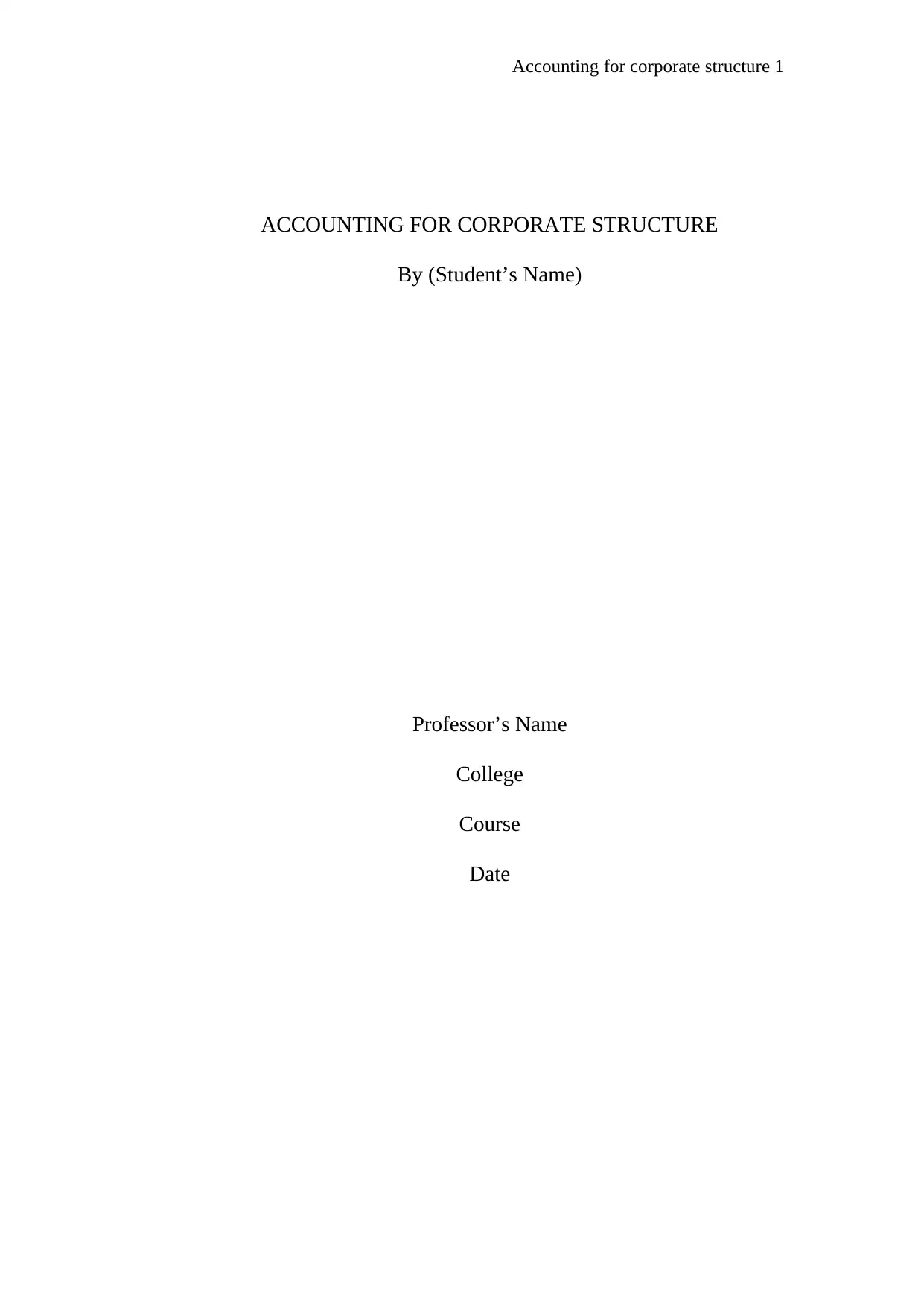
Accounting for corporate structure 1
ACCOUNTING FOR CORPORATE STRUCTURE
By (Student’s Name)
Professor’s Name
College
Course
Date
ACCOUNTING FOR CORPORATE STRUCTURE
By (Student’s Name)
Professor’s Name
College
Course
Date
Paraphrase This Document
Need a fresh take? Get an instant paraphrase of this document with our AI Paraphraser
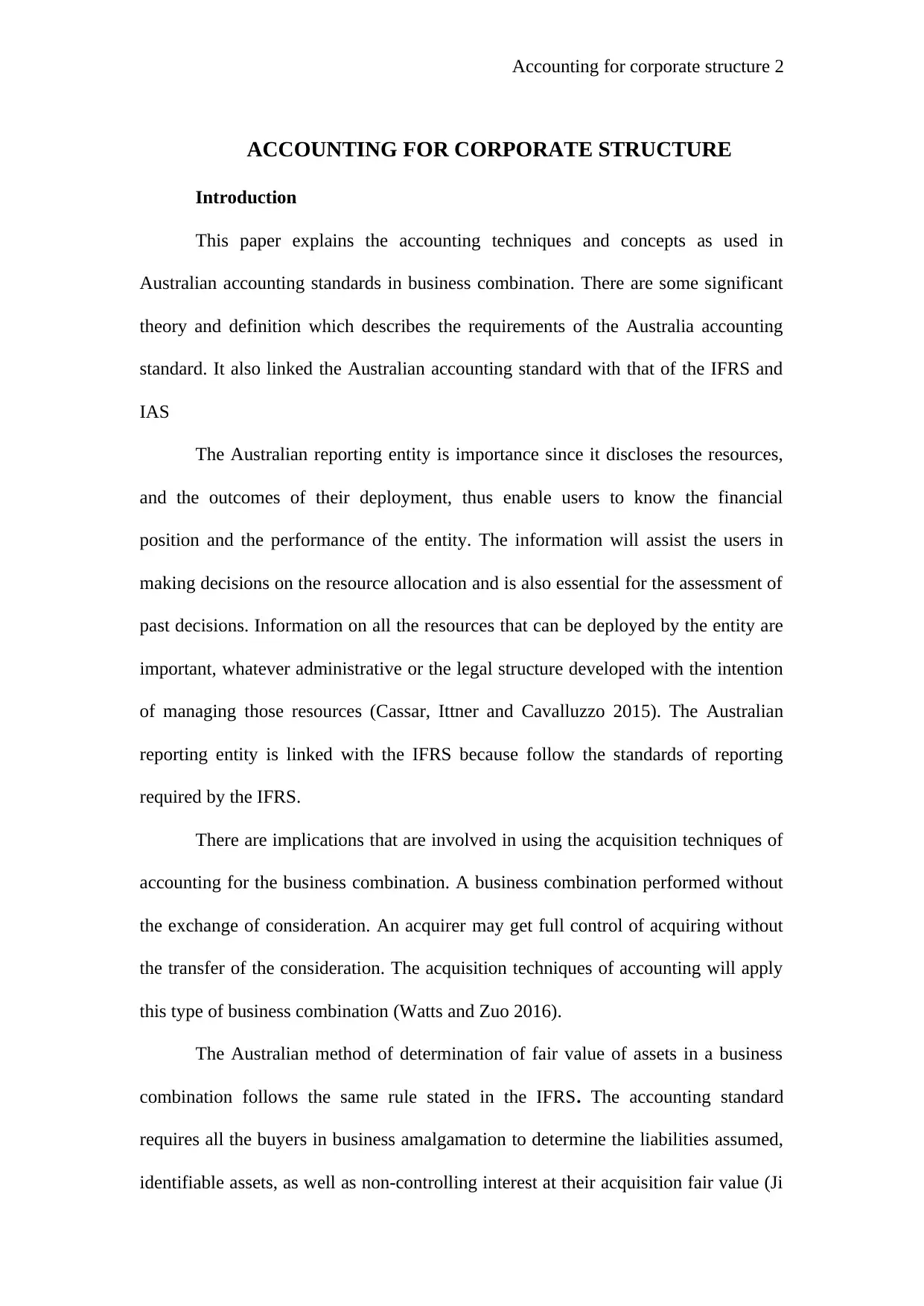
Accounting for corporate structure 2
ACCOUNTING FOR CORPORATE STRUCTURE
Introduction
This paper explains the accounting techniques and concepts as used in
Australian accounting standards in business combination. There are some significant
theory and definition which describes the requirements of the Australia accounting
standard. It also linked the Australian accounting standard with that of the IFRS and
IAS
The Australian reporting entity is importance since it discloses the resources,
and the outcomes of their deployment, thus enable users to know the financial
position and the performance of the entity. The information will assist the users in
making decisions on the resource allocation and is also essential for the assessment of
past decisions. Information on all the resources that can be deployed by the entity are
important, whatever administrative or the legal structure developed with the intention
of managing those resources (Cassar, Ittner and Cavalluzzo 2015). The Australian
reporting entity is linked with the IFRS because follow the standards of reporting
required by the IFRS.
There are implications that are involved in using the acquisition techniques of
accounting for the business combination. A business combination performed without
the exchange of consideration. An acquirer may get full control of acquiring without
the transfer of the consideration. The acquisition techniques of accounting will apply
this type of business combination (Watts and Zuo 2016).
The Australian method of determination of fair value of assets in a business
combination follows the same rule stated in the IFRS. The accounting standard
requires all the buyers in business amalgamation to determine the liabilities assumed,
identifiable assets, as well as non-controlling interest at their acquisition fair value (Ji
ACCOUNTING FOR CORPORATE STRUCTURE
Introduction
This paper explains the accounting techniques and concepts as used in
Australian accounting standards in business combination. There are some significant
theory and definition which describes the requirements of the Australia accounting
standard. It also linked the Australian accounting standard with that of the IFRS and
IAS
The Australian reporting entity is importance since it discloses the resources,
and the outcomes of their deployment, thus enable users to know the financial
position and the performance of the entity. The information will assist the users in
making decisions on the resource allocation and is also essential for the assessment of
past decisions. Information on all the resources that can be deployed by the entity are
important, whatever administrative or the legal structure developed with the intention
of managing those resources (Cassar, Ittner and Cavalluzzo 2015). The Australian
reporting entity is linked with the IFRS because follow the standards of reporting
required by the IFRS.
There are implications that are involved in using the acquisition techniques of
accounting for the business combination. A business combination performed without
the exchange of consideration. An acquirer may get full control of acquiring without
the transfer of the consideration. The acquisition techniques of accounting will apply
this type of business combination (Watts and Zuo 2016).
The Australian method of determination of fair value of assets in a business
combination follows the same rule stated in the IFRS. The accounting standard
requires all the buyers in business amalgamation to determine the liabilities assumed,
identifiable assets, as well as non-controlling interest at their acquisition fair value (Ji
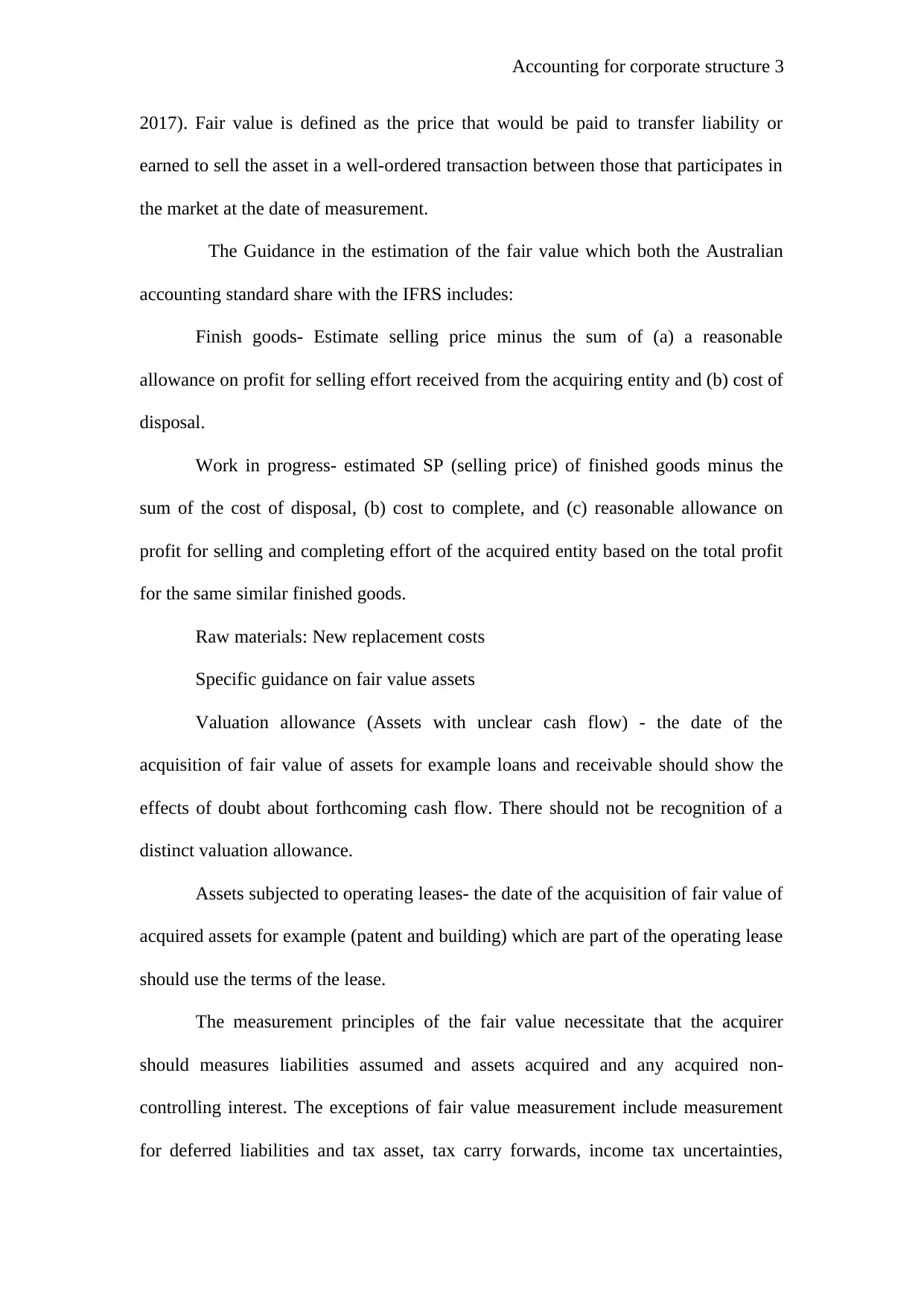
Accounting for corporate structure 3
2017). Fair value is defined as the price that would be paid to transfer liability or
earned to sell the asset in a well-ordered transaction between those that participates in
the market at the date of measurement.
The Guidance in the estimation of the fair value which both the Australian
accounting standard share with the IFRS includes:
Finish goods- Estimate selling price minus the sum of (a) a reasonable
allowance on profit for selling effort received from the acquiring entity and (b) cost of
disposal.
Work in progress- estimated SP (selling price) of finished goods minus the
sum of the cost of disposal, (b) cost to complete, and (c) reasonable allowance on
profit for selling and completing effort of the acquired entity based on the total profit
for the same similar finished goods.
Raw materials: New replacement costs
Specific guidance on fair value assets
Valuation allowance (Assets with unclear cash flow) - the date of the
acquisition of fair value of assets for example loans and receivable should show the
effects of doubt about forthcoming cash flow. There should not be recognition of a
distinct valuation allowance.
Assets subjected to operating leases- the date of the acquisition of fair value of
acquired assets for example (patent and building) which are part of the operating lease
should use the terms of the lease.
The measurement principles of the fair value necessitate that the acquirer
should measures liabilities assumed and assets acquired and any acquired non-
controlling interest. The exceptions of fair value measurement include measurement
for deferred liabilities and tax asset, tax carry forwards, income tax uncertainties,
2017). Fair value is defined as the price that would be paid to transfer liability or
earned to sell the asset in a well-ordered transaction between those that participates in
the market at the date of measurement.
The Guidance in the estimation of the fair value which both the Australian
accounting standard share with the IFRS includes:
Finish goods- Estimate selling price minus the sum of (a) a reasonable
allowance on profit for selling effort received from the acquiring entity and (b) cost of
disposal.
Work in progress- estimated SP (selling price) of finished goods minus the
sum of the cost of disposal, (b) cost to complete, and (c) reasonable allowance on
profit for selling and completing effort of the acquired entity based on the total profit
for the same similar finished goods.
Raw materials: New replacement costs
Specific guidance on fair value assets
Valuation allowance (Assets with unclear cash flow) - the date of the
acquisition of fair value of assets for example loans and receivable should show the
effects of doubt about forthcoming cash flow. There should not be recognition of a
distinct valuation allowance.
Assets subjected to operating leases- the date of the acquisition of fair value of
acquired assets for example (patent and building) which are part of the operating lease
should use the terms of the lease.
The measurement principles of the fair value necessitate that the acquirer
should measures liabilities assumed and assets acquired and any acquired non-
controlling interest. The exceptions of fair value measurement include measurement
for deferred liabilities and tax asset, tax carry forwards, income tax uncertainties,
⊘ This is a preview!⊘
Do you want full access?
Subscribe today to unlock all pages.

Trusted by 1+ million students worldwide
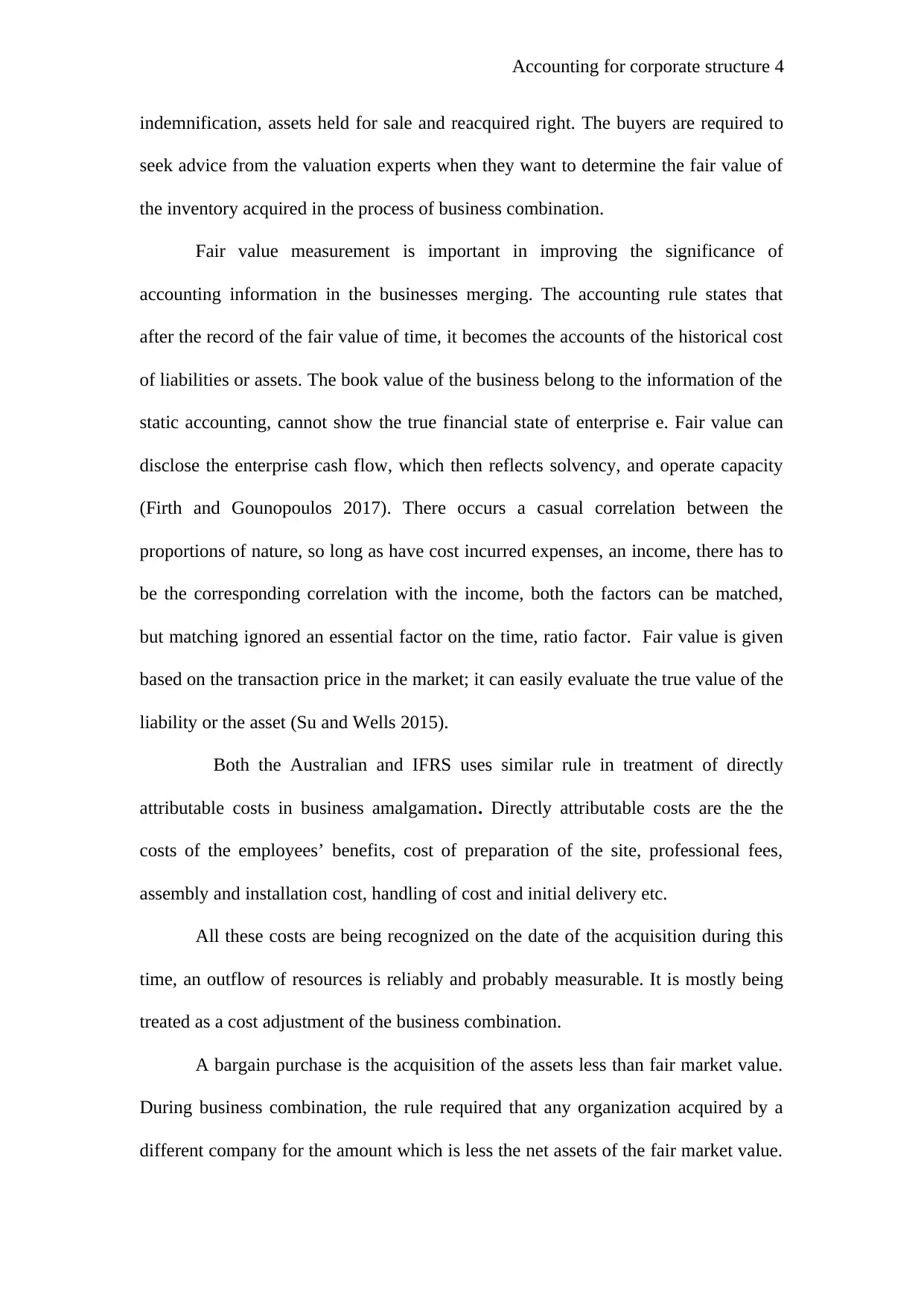
Accounting for corporate structure 4
indemnification, assets held for sale and reacquired right. The buyers are required to
seek advice from the valuation experts when they want to determine the fair value of
the inventory acquired in the process of business combination.
Fair value measurement is important in improving the significance of
accounting information in the businesses merging. The accounting rule states that
after the record of the fair value of time, it becomes the accounts of the historical cost
of liabilities or assets. The book value of the business belong to the information of the
static accounting, cannot show the true financial state of enterprise e. Fair value can
disclose the enterprise cash flow, which then reflects solvency, and operate capacity
(Firth and Gounopoulos 2017). There occurs a casual correlation between the
proportions of nature, so long as have cost incurred expenses, an income, there has to
be the corresponding correlation with the income, both the factors can be matched,
but matching ignored an essential factor on the time, ratio factor. Fair value is given
based on the transaction price in the market; it can easily evaluate the true value of the
liability or the asset (Su and Wells 2015).
Both the Australian and IFRS uses similar rule in treatment of directly
attributable costs in business amalgamation. Directly attributable costs are the the
costs of the employees’ benefits, cost of preparation of the site, professional fees,
assembly and installation cost, handling of cost and initial delivery etc.
All these costs are being recognized on the date of the acquisition during this
time, an outflow of resources is reliably and probably measurable. It is mostly being
treated as a cost adjustment of the business combination.
A bargain purchase is the acquisition of the assets less than fair market value.
During business combination, the rule required that any organization acquired by a
different company for the amount which is less the net assets of the fair market value.
indemnification, assets held for sale and reacquired right. The buyers are required to
seek advice from the valuation experts when they want to determine the fair value of
the inventory acquired in the process of business combination.
Fair value measurement is important in improving the significance of
accounting information in the businesses merging. The accounting rule states that
after the record of the fair value of time, it becomes the accounts of the historical cost
of liabilities or assets. The book value of the business belong to the information of the
static accounting, cannot show the true financial state of enterprise e. Fair value can
disclose the enterprise cash flow, which then reflects solvency, and operate capacity
(Firth and Gounopoulos 2017). There occurs a casual correlation between the
proportions of nature, so long as have cost incurred expenses, an income, there has to
be the corresponding correlation with the income, both the factors can be matched,
but matching ignored an essential factor on the time, ratio factor. Fair value is given
based on the transaction price in the market; it can easily evaluate the true value of the
liability or the asset (Su and Wells 2015).
Both the Australian and IFRS uses similar rule in treatment of directly
attributable costs in business amalgamation. Directly attributable costs are the the
costs of the employees’ benefits, cost of preparation of the site, professional fees,
assembly and installation cost, handling of cost and initial delivery etc.
All these costs are being recognized on the date of the acquisition during this
time, an outflow of resources is reliably and probably measurable. It is mostly being
treated as a cost adjustment of the business combination.
A bargain purchase is the acquisition of the assets less than fair market value.
During business combination, the rule required that any organization acquired by a
different company for the amount which is less the net assets of the fair market value.
Paraphrase This Document
Need a fresh take? Get an instant paraphrase of this document with our AI Paraphraser
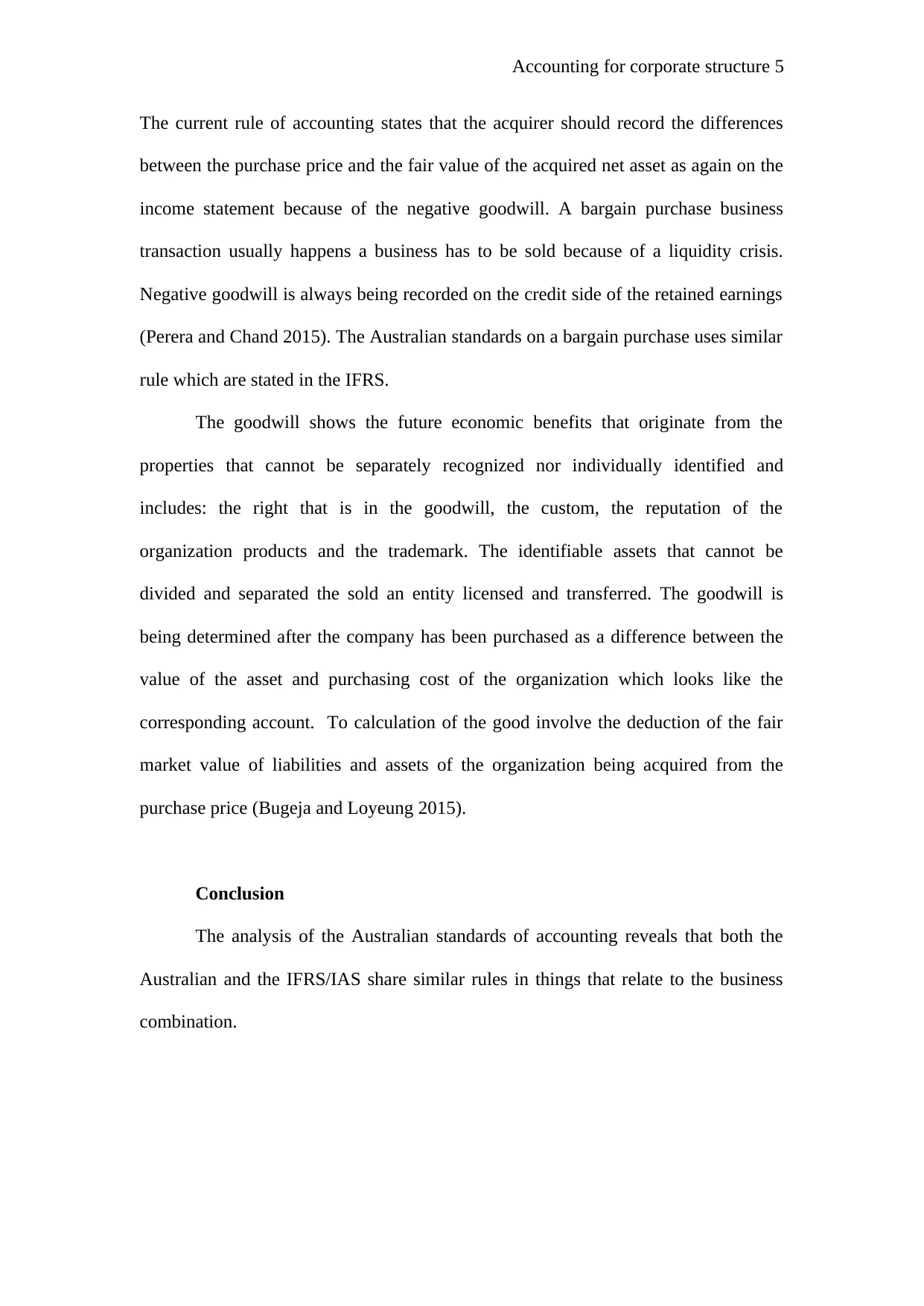
Accounting for corporate structure 5
The current rule of accounting states that the acquirer should record the differences
between the purchase price and the fair value of the acquired net asset as again on the
income statement because of the negative goodwill. A bargain purchase business
transaction usually happens a business has to be sold because of a liquidity crisis.
Negative goodwill is always being recorded on the credit side of the retained earnings
(Perera and Chand 2015). The Australian standards on a bargain purchase uses similar
rule which are stated in the IFRS.
The goodwill shows the future economic benefits that originate from the
properties that cannot be separately recognized nor individually identified and
includes: the right that is in the goodwill, the custom, the reputation of the
organization products and the trademark. The identifiable assets that cannot be
divided and separated the sold an entity licensed and transferred. The goodwill is
being determined after the company has been purchased as a difference between the
value of the asset and purchasing cost of the organization which looks like the
corresponding account. To calculation of the good involve the deduction of the fair
market value of liabilities and assets of the organization being acquired from the
purchase price (Bugeja and Loyeung 2015).
Conclusion
The analysis of the Australian standards of accounting reveals that both the
Australian and the IFRS/IAS share similar rules in things that relate to the business
combination.
The current rule of accounting states that the acquirer should record the differences
between the purchase price and the fair value of the acquired net asset as again on the
income statement because of the negative goodwill. A bargain purchase business
transaction usually happens a business has to be sold because of a liquidity crisis.
Negative goodwill is always being recorded on the credit side of the retained earnings
(Perera and Chand 2015). The Australian standards on a bargain purchase uses similar
rule which are stated in the IFRS.
The goodwill shows the future economic benefits that originate from the
properties that cannot be separately recognized nor individually identified and
includes: the right that is in the goodwill, the custom, the reputation of the
organization products and the trademark. The identifiable assets that cannot be
divided and separated the sold an entity licensed and transferred. The goodwill is
being determined after the company has been purchased as a difference between the
value of the asset and purchasing cost of the organization which looks like the
corresponding account. To calculation of the good involve the deduction of the fair
market value of liabilities and assets of the organization being acquired from the
purchase price (Bugeja and Loyeung 2015).
Conclusion
The analysis of the Australian standards of accounting reveals that both the
Australian and the IFRS/IAS share similar rules in things that relate to the business
combination.
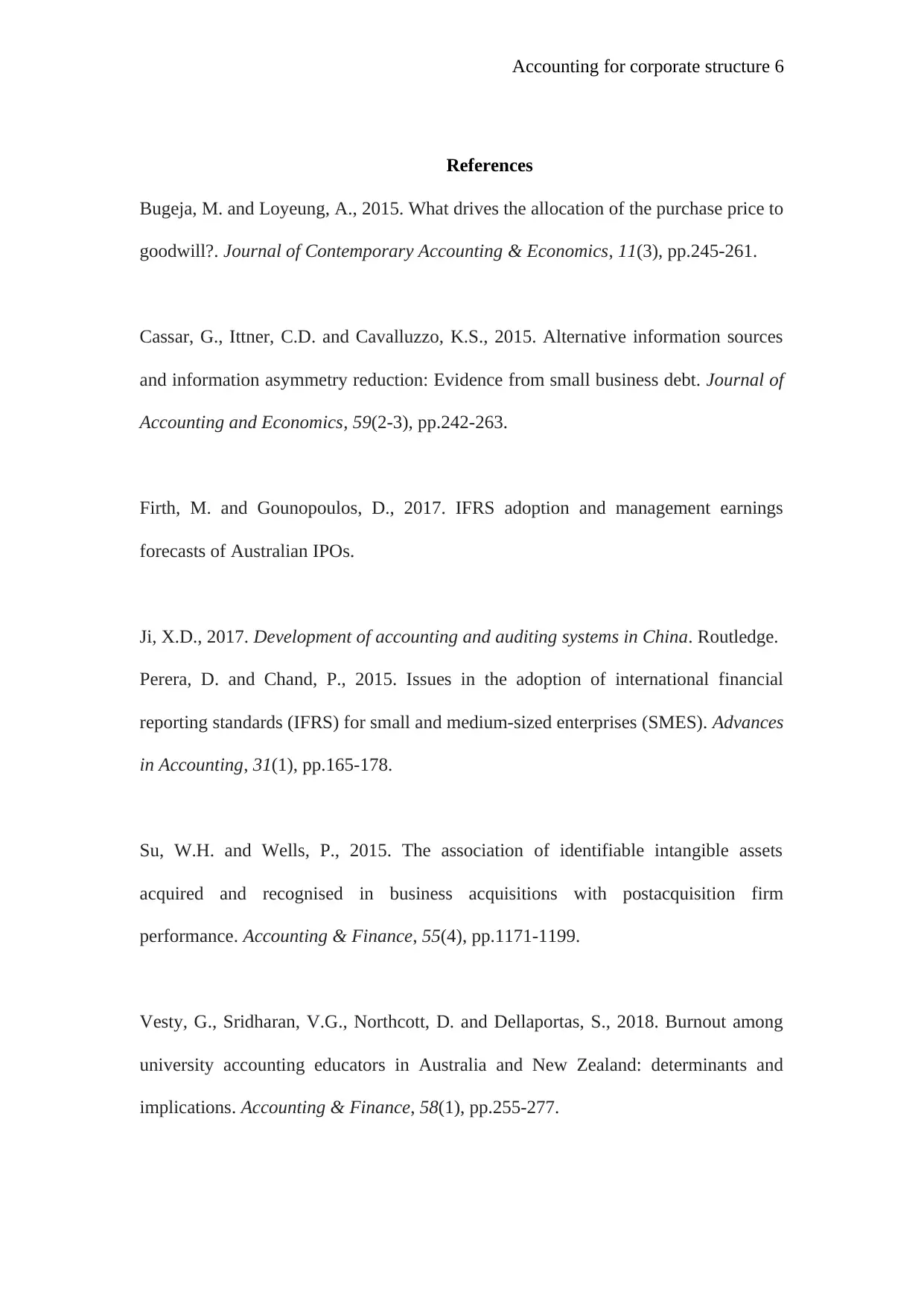
Accounting for corporate structure 6
References
Bugeja, M. and Loyeung, A., 2015. What drives the allocation of the purchase price to
goodwill?. Journal of Contemporary Accounting & Economics, 11(3), pp.245-261.
Cassar, G., Ittner, C.D. and Cavalluzzo, K.S., 2015. Alternative information sources
and information asymmetry reduction: Evidence from small business debt. Journal of
Accounting and Economics, 59(2-3), pp.242-263.
Firth, M. and Gounopoulos, D., 2017. IFRS adoption and management earnings
forecasts of Australian IPOs.
Ji, X.D., 2017. Development of accounting and auditing systems in China. Routledge.
Perera, D. and Chand, P., 2015. Issues in the adoption of international financial
reporting standards (IFRS) for small and medium-sized enterprises (SMES). Advances
in Accounting, 31(1), pp.165-178.
Su, W.H. and Wells, P., 2015. The association of identifiable intangible assets
acquired and recognised in business acquisitions with postacquisition firm
performance. Accounting & Finance, 55(4), pp.1171-1199.
Vesty, G., Sridharan, V.G., Northcott, D. and Dellaportas, S., 2018. Burnout among
university accounting educators in Australia and New Zealand: determinants and
implications. Accounting & Finance, 58(1), pp.255-277.
References
Bugeja, M. and Loyeung, A., 2015. What drives the allocation of the purchase price to
goodwill?. Journal of Contemporary Accounting & Economics, 11(3), pp.245-261.
Cassar, G., Ittner, C.D. and Cavalluzzo, K.S., 2015. Alternative information sources
and information asymmetry reduction: Evidence from small business debt. Journal of
Accounting and Economics, 59(2-3), pp.242-263.
Firth, M. and Gounopoulos, D., 2017. IFRS adoption and management earnings
forecasts of Australian IPOs.
Ji, X.D., 2017. Development of accounting and auditing systems in China. Routledge.
Perera, D. and Chand, P., 2015. Issues in the adoption of international financial
reporting standards (IFRS) for small and medium-sized enterprises (SMES). Advances
in Accounting, 31(1), pp.165-178.
Su, W.H. and Wells, P., 2015. The association of identifiable intangible assets
acquired and recognised in business acquisitions with postacquisition firm
performance. Accounting & Finance, 55(4), pp.1171-1199.
Vesty, G., Sridharan, V.G., Northcott, D. and Dellaportas, S., 2018. Burnout among
university accounting educators in Australia and New Zealand: determinants and
implications. Accounting & Finance, 58(1), pp.255-277.
⊘ This is a preview!⊘
Do you want full access?
Subscribe today to unlock all pages.

Trusted by 1+ million students worldwide
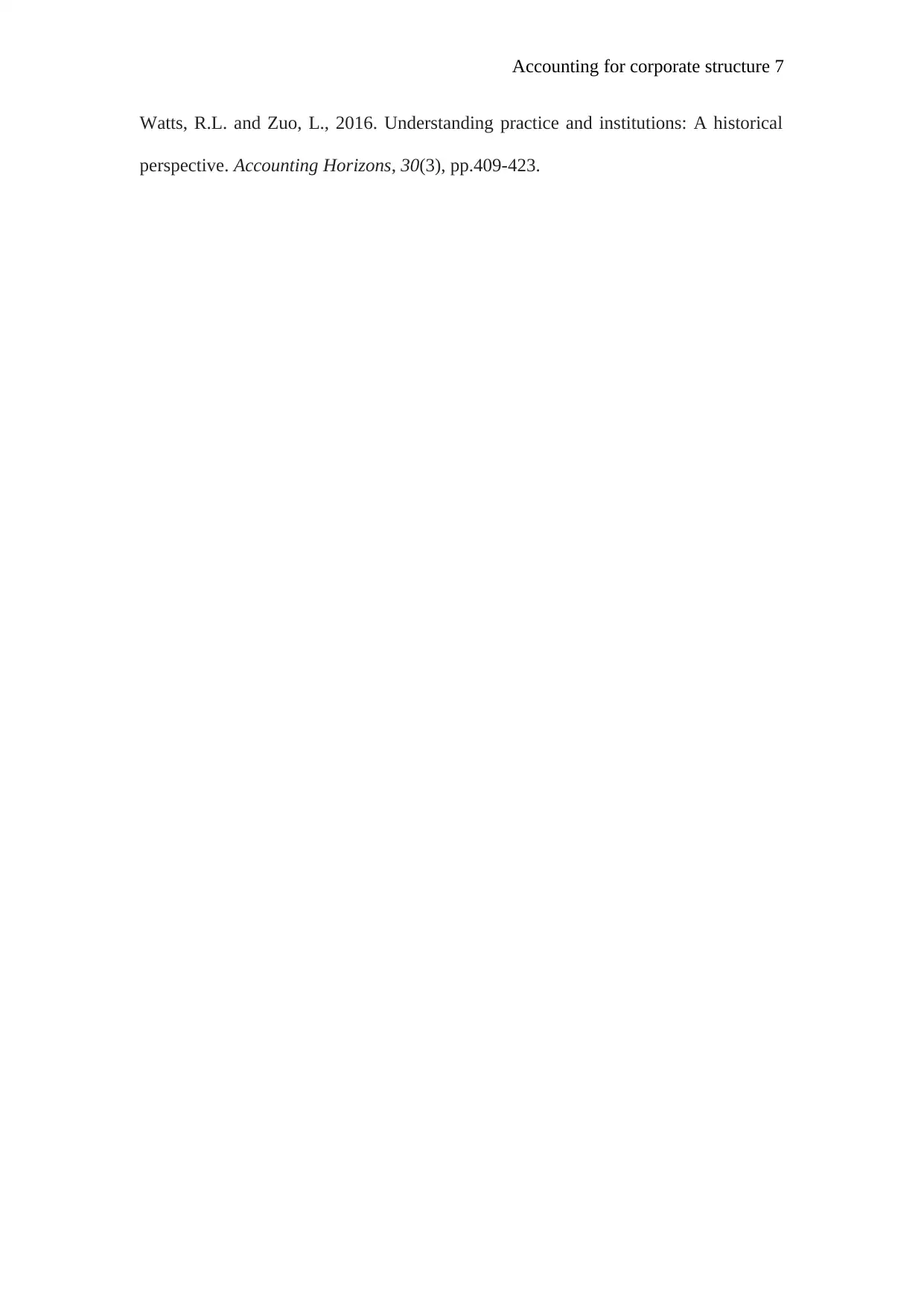
Accounting for corporate structure 7
Watts, R.L. and Zuo, L., 2016. Understanding practice and institutions: A historical
perspective. Accounting Horizons, 30(3), pp.409-423.
Watts, R.L. and Zuo, L., 2016. Understanding practice and institutions: A historical
perspective. Accounting Horizons, 30(3), pp.409-423.
1 out of 7
Related Documents
Your All-in-One AI-Powered Toolkit for Academic Success.
+13062052269
info@desklib.com
Available 24*7 on WhatsApp / Email
![[object Object]](/_next/static/media/star-bottom.7253800d.svg)
Unlock your academic potential
Copyright © 2020–2025 A2Z Services. All Rights Reserved. Developed and managed by ZUCOL.




